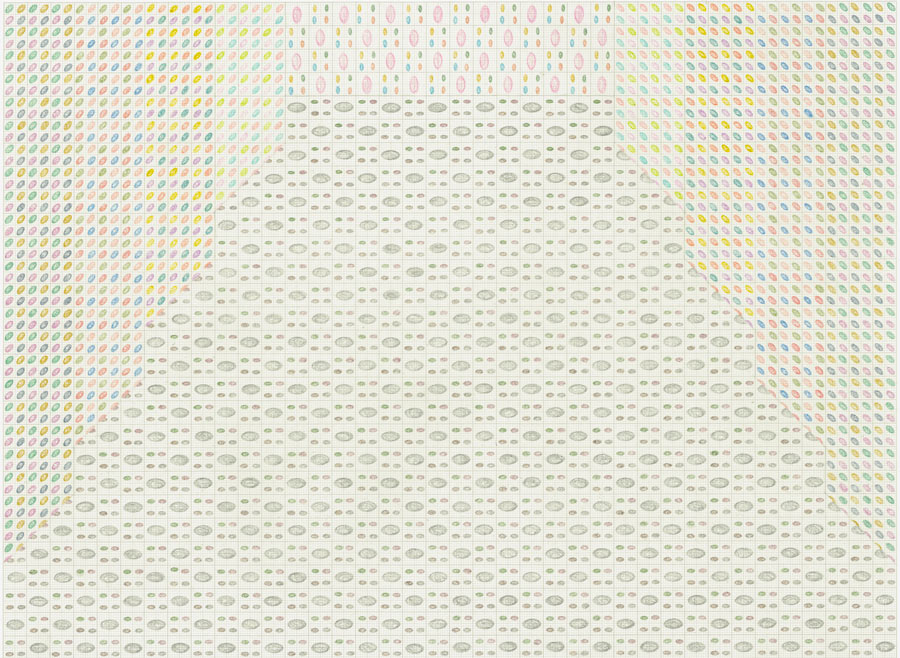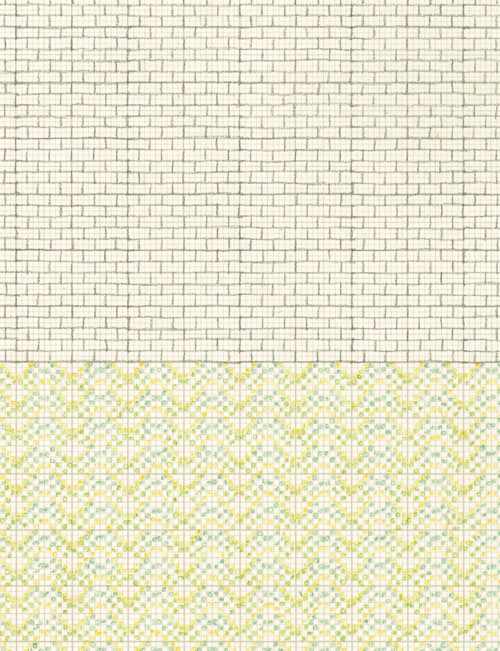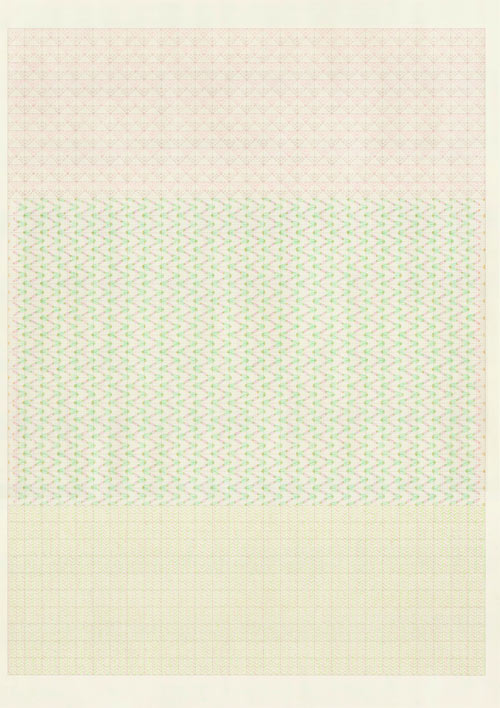

Stage #4, Colored Pencil on Graph Paper, 11.5 x 16.5in, 2014, Courtesy of Foley Gallery
I always judge a book by its cover. As an artist and visual thinker, it’s almost impossible not to. OK, it’s a flawed system, but I’m drawn to books with bright colors or old fashioned decorative patterns. I prefer illustrated covers to photographic ones because I find photos of real places or real people limiting to the imagination. I’m sure I’ve missed many good books over the years due to this prejudice, yet sometimes a beautiful cover marks the beginning of a long journey – an unanticipated obsession. In the summer of 2010, while waiting in line for a coffee at Rock City Coffee and Books in Rockland, ME, exactly this happened. My eyes went straight to a black and white illustrated cover of Shirley Jackson’s We Have Always Lived in the Castle, the recently re-released Penguin edition that features the characters Merricat and Constance – two sisters whom I would come to love. Merricat is holding Jonas, her black cat. Behind them, an angry mob gathers. Stuck to the book was a little pink book Post-it note that read “just read the first paragraph…” My latte wasn’t ready yet, so I did.
“My name is Mary Katherine Blackwood. I am eighteen years old, and I live with my sister Constance. I have often thought that with any luck at all, I could have been born a werewolf, because the two middle fingers on both my hands are the same length, but I’ve had to be content with what I had. I dislike washing myself, and dogs and noise. I like my sister Constance and Richard Plantagenet and Amanita phalloides, the death-cup mushroom. Everyone else in our family is dead.”
Sold. I walked home, intending to take my coffee into my studio and start working, but when I got back to my house, I didn’t even put the key in the door. I just sat down on the porch and started reading:
“Blackwoods had always lived in our house, and kept their things in order; as soon as a new Blackwood wife moved in, a place was found for her belongings, and so our house was built up with layers of Blackwood property weighing it, and keeping it steady against the world.”
…sometimes a beautiful cover marks the beginning of a long journey – an unanticipated obsession.


Stage #2, Colored Pencil on Graph Paper, 11.5 x 16.5in, 2014, Courtesy of Foley Gallery
Stage #2 (detail)
Shirley Jackson believed that houses had an inner life and could impose their will on the people who live there, even change the course of their lives. Houses can make the inhabitants believe things that simply aren’t true. They don’t just provide shelter, they lie and they bully as well. Houses don’t forget, they remind.
At the time, I’d only been living in my Rockland house for a month, after five years in London. The house was a white 1892 structure that stood proud, though showing some of the deteriorating affects of Father Time. In London, my husband and I had moved from one tiny flat to another, so this house felt like a castle by comparison. It was a house with “good bones,” as my dad had remarked when we bought it. I love that phrase. My house had a skeleton and a heart and skin. Like all old houses, it was in its own way, alive.


Terrain #2 (detail)
Colored Pencil on Graph Paper
16.5 x 11.5in
2014
Courtesy of Foley Gallery
Since reading Castle, I’ve read all of Jackson’s novels and all but a few of her short stories and her preoccupation with the personality of houses is constant. In We Have Always Lived in the Castle, Haunting of Hill House, and The Sundial, the home is as much a character as a setting. From the Haunting of Hill House:
“Hill House, not sane, stood by itself against its hills, holding darkness within; it had stood so for eighty years and might stand for eighty more. Within, walls continued upright, bricks met neatly, floors were firm, and doors sensibly shut; silence lay steadily against the wood and stone of Hill House, and whatever walked there, walked alone.”
As a lover of old houses, I connected immediately to the power Jackson bestows on domestic spaces. I see houses as vessels containing memories, injustices, fears, secrets, imperfections, doubts, dust and, of course, lots of knick-knacks. They are repositories for taste, both good and bad. Nervous energy ebbs and flows in a house, especially among the busy patterns of carpets, walls and upholsteries that serve as the backdrops of daily life. I find the inspiration for my drawings in this anxious order.
Shirley Jackson understood how attempts to impose order on the chaos of the mind all too often result in anxiety. People ask me all the time if it’s soothing to make my highly patterned drawings. The answer is no, not at all. In fact, I’m surprised when people imagine otherwise. Stress is the natural result of repetitive work. I’m not a machine, even though, sitting at my drawing table, I’m compelled to behave like one. There’s a fine line between beauty and monotony. When it comes to drawing patterns, I’m always treading that line.
Nervous energy ebbs and flows in a house, especially among the busy patterns of carpets, walls and upholsteries that serve as the backdrops of daily life.


Ruthless Ornamentation #3 (2013), Ruthless Ornamentation #4 (2014), Ruthless Ornamentation #2 (2013)
All Colored Pencil on Graph Paper, 16.5 x 11.5in, Courtesy of Foley Gallery
Many artists claim their work is a manifestation of that thing that simultaneously attracts and repels them. For me, this is order, repetition and pattern. Even as I strive to create within their confines, patterns in both natural and material worlds can cause me anxiety. In The Bird’s Nest, Jackson, to great comic affect, illustrates a fascination/repulsion with pattern, particularly domestic interiors, and for which a series of my drawings (Ruthless Ornamentation) is named:
“The house where they lived, in a neighborhood generally regarded as the most exclusive in our town, had, I thought, been put together by some family eccentric whose taste found its most perfect expression in the bleak, pudding-colored style so popular not too long ago among our grandparents, when taste and financial security were felt to be most surely expressed by a kind of ruthless ornamentation.”
“Ruthless ornamentation” perfectly describes not only my drawing process, but also the effect that detailed patterning can have on the eye. It’s akin to the concept of “horror vacui,” or “a fear of empty space,” which is a phrase used in connection with certain medieval illuminators’ preoccupation with filling the page and their refusal to leave any of it blank. Jackson evokes this terror perfectly in her characters’ decorative compulsions. In fact, she goes further to pass judgment on personalities that have been shaped by this fear:
Many artists claim their work is a manifestation of that thing that simultaneously attracts and repels them. For me, this is order, repetition and pattern.


Terrain #1
Colored Pencil on Graph Paper
16.5 x 11.5
2014
Courtesy of Foley Gallery
“…the chair in which Elizabeth sat was…upholstered in a kind of cloudy orange, her feet lay on a carpet in which a scarlet key design ran in and out and around a geometric floral affair in green and brown, and the wallpaper, pervading and emphasizing the room, and somehow the Arrows, presented the inadvertent viewer with alternate squares of blue and green, relieved almost haphazardly by touches of black. There was nothing of harmony, nothing of humor…there was everything of compromise and yet, comfortably, a kind of deep security in the unmistakable realization that all this belonged without dispute to the Arrows, was unmovable and after a while almost tolerable, and was, beyond everything else, solid. Not even Aunt Morgen could deny the Arrows the reality of their living room…Mr. and Mrs. Arrow brought with them, and spread infectiously, an air of unfading wallpaper and practical carpeting, of ironclad and frequently unendurable mediocrity.”
For Jackson’s characters, their fear of empty space goes beyond the blank page, entering their psyche. That which is ordered, covered in pattern or filled with color refuses to allow for chaos, and leaves no room for uncertainty. Similarly, my recent series of drawings, Settings, references stage design as a way of evoking an interior environment. The idea is to create a confined space by filling it relentlessly with pattern and color, resulting in a mixture of beauty and claustrophobia. As Jackson’s characters’ so often illustrate, those who seek the most control are those most likely to lose it, an irony I deal with every day when I sit down in my studio to draw. But, that’s precisely where the urgency and the tension come from. Even more importantly, it’s where the attraction is because,
“Fear is the relinquishment of logic, the willing relinquishment of reasonable patterns. We yield to it or we fight it, but we cannot meet it halfway.” (The Haunting of Hill House)


Stage #3, Colored Pencil on Graph Paper, 11.5 x 16.5in, 2014, Courtesy of Foley Gallery
Stage #1, Colored Pencil on Graph Paper, 11.5 x 16.5in, 2014, Courtesy of Foley Gallery